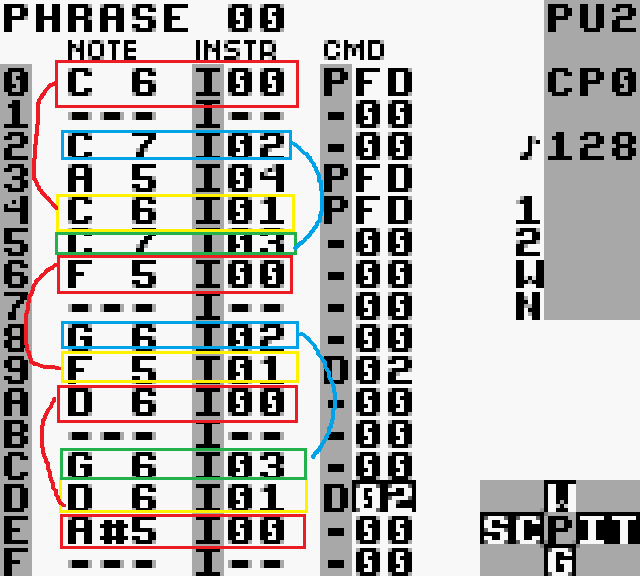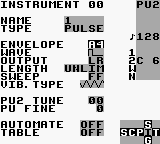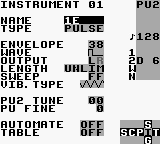If the melody is more varied notewise then you can just not enter the echo'd note.
Your ear will trick you...Or you can use the other channel and fit it in there...Or you can put it the line before and use D03 which works occasionally.
chipmusic.org is an online community in respect and relation to chip music, art and its parallels.
You are not logged in. Please login or register.
If the melody is more varied notewise then you can just not enter the echo'd note.
Your ear will trick you...Or you can use the other channel and fit it in there...Or you can put it the line before and use D03 which works occasionally.
It's also fun to experiment with the location of the echos. Much later, or directly after.
If a melody is more complex, and following the above example means putting an echo on a lead note, then you can sneak it in just beforehand, and try using a Dxx command to delay it so it starts ALMOST when it should, but gets cut off by the next note. Or, you can put the note after the next lead note, which would fall on the step that you would have had an echo, again, using a Dxx command to fit to taste. Or simply lose that echo entirely
examples here
forgive the small image size, i took screen caps from VBA.
First, here is your "complex" melody.
Actually, its just a melody that will cause problems using the delay of 4 steps, or could cause those problems
here is a solution to that problem. The delay is not exactly equal, but because its close enough, the ear shouldn't mind. You can increase the Dxx value if you are a stickler, but without enough length, the echo won't sound effective. You can tailor it to your own ear though.
You can also overlay a 2nd melody, with a 2nd set of echoes, as you see here. I have opted not to use the Dxx command on the 2nd set of leads/delays because I actually just forgot to, but the notes with instrument 03 should have a D02 command on them, or some Dxx value.
NOTE:
on line 0, there is a C-6 note.
on line 2, there is a very short note with envelope A1. It cuts off the note on line 0. However, the note on line 0 has a longer envelope, and should still be heard at this point (if it were 2 channels, you'd still hear that first note playing)
SO. On line 3, there is a note continuing that Pitch bend. It is at a lower volume (following the envelope set at step 0) and at a lower pitch (following the PFD command on step 0). THis is optional, i liked how it sounded, but you dont' have to use it. You can do whatever you think sounds good to you.
and to make it more clear what is going on, you can see here (in this horrible png) that the red notes are followed by yellow echoes, the blue notes are followed by green echoes. 
Here are the instruments
Lead 1
Echo 1 (panned left)
Lead 2 (panned right)
Echo 2 (panned right)
The result is two distinct instruments (on two separate octaves, with 2 separate pulse widths, panned separately) that should be distinctly heard
The general idea in this is that your echos dont' have to be precisely the same at all times. You can even abandon an echo if there's no way to fit it without sounding bad, or cutting off a note early that youw ant to keep ringing. below is the audio of this example. I hope this is helpful. This is by no means the only way to do things, but it should give you some ideas to try things on your own.
http://www.churchofinternet.com/lsdjtut … torial.mp3
Last edited by Hawkfather (Jan 8, 2010 7:05 pm)
Another approach:
Screens showing instrument used to create delay effect.
Note that both phrases should be identical except for instruments.Using this approach you can set a delay value per tick. (Try increasing the H commands first digit for longer delay.)
\
another method in the tables is using a G00 in the tables... to slow the table down.. then use the O command to "slice" the sound w/ a longer decay to give the sound of echo.. it works nice.
this is a messabout just to show people what nitro2k1's tutorial sounds like, his melody + echo come in at 0:13
Whoa! More awesome than I could've made it. Although there's almost a little too much wav bass for my taste. Pulse channels drown in it if you know what I mean.
you made one very happy cheapshot!
loving the tutorials guys. keep it up!
Thank You Nitro2k01 you have helped you on a part of my track that i got writers block on.
This patch should be very useful. Thanks
Last edited by SAMWAVE (Jan 13, 2010 12:28 pm)
not seen that anyone has mentioned just using the volume column in a table
Have a few ticks on full volume, a few of 0 volume, a few of a slightly lower volume, a few of 0 volume, etc...
only really works if your not trying to fit a bunch of other stuff in the channel and you get lots of clicking sounds using the volume column in tables.
ive used it on a few (as yet!) unreleased remixes that i was asked to do recently, with rather nice results.
Last edited by Jellica (Jan 13, 2010 1:09 pm)
I prefer using the E command in a table instead of the volume column.
Another way of getting a delay sound out of LSDJ is to stick in this table.
In the CMD section on the right, try this.
Table
0 W 50%
1
2 W 25%
3
4 W 50%
This one is especially useful if you want to keep the CMD section on your Phrase screen free.
the only delay effect I've made is setting a lead like anyone normally would (VOL: F5 or whatever)
then in the table at 08 i put and E:1F (or any other varying degrees of high attacks)
not a true delay, but a nice delayingish pulse sound.
sorry no pics